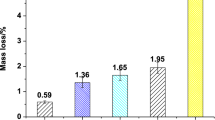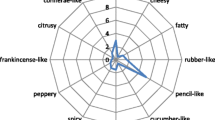Abstract
In a previous study, we identified carbonyls as highly odor-active compounds in both unprocessed and processed polypropylene (PP) with higher intensities after processing, indicating a temperature-driven forming mechanism. In the presented work, we studied whether (a) these carbonyls are the major odor drivers to the overall odor of polyolefins, (b) their formation is taking place already at moderate temperatures well below the typical processing temperatures, (c) conventional antioxidants in polyolefins can prevent or reduce their formation, and (d) whether reducing the amount of oxygen present can decrease the overall odor. One polyethylene (PE) and one PP were selected, and both stabilized and unstabilized polymer powder samples were exposed to conditions differing in oxygen concentration and aging time. The changes in the volatile fraction as well as the formation of odor-active compounds were monitored using a multidisciplinary approach by combining analytical methods based on gas chromatography (GC), multivariate data analysis, and sensory methods (GC–olfactometry and a sensory panel). Both investigated materials (PE and PP) showed similar degradation products (aldehydes, ketones, carboxylic acids, alcohols, and lactones) which increased dramatically with increasing aging time and the lack of stabilization. Oxidation products, mainly carbonyl compounds, were responsible for the odor of the investigated materials. The main odor drivers were unsaturated ketones and aldehydes with a chain length between six and nine C-atoms. Interestingly, similar odor patterns were found for both stabilized and unstabilized samples, indicating that similar formation processes take place independent of the stabilization.

Combining analytical and sensory odor analysis methods










Similar content being viewed by others
References
Plastics Europe (2010) The compelling facts about plastics 2009. www.plasticseurope.org. Accessed 16 July 2010
VDA 270 (1992) Determination of the odor characteristics of trim materials in motor vehicles. German Association of the Automotive Industry (VDA)
Laing DG, Link C, Jinks A, Hutchinson I (2002) Perception 31:617–635
VDA 276 (2000) Determination of organic emissions from automotive parts using a 1 m3-testing chamber. German Association of the Automotive Industry (VDA)
VDA 277 (1995) Non-metallic materials for automotive interior—determination of emission of organic compounds. German Association of the Automotive Industry (VDA)
VDA 278 (2002) Thermo desorption analysis of organic emissions for characterisation of non-metallic materials for automobiles. German Association of the Automotive Industry (VDA)
Bravo A, Hotchkiss JH, Acree TE (1992) J Agric Food Chem 40:1881–1885
Rebeyrolle-Bernard P, Etievant P (1993) J Appl Polym Sci 49:1159–1164
Villberg K, Veijanen A, Gustafsson I, Wickström K (1997) J Chromatogr A 791:213–219
Villberg K, Veijanen A (2001) Anal Chem 73:971–977
Skjervak I, Due A, Gjerstad KO, Herikstad H (2003) Water Res 37:1912–1920
Tyapkova O, Czerny M, Buettner A (2009) Polym Degrad Stab 94:757–769
Hopfer H, Haar N, Koraimann C, Leitner E (2010) In: Blank I, Wüst M, Yeretzian C (eds) Expression of multidisciplinary flavour science. Züricher Hochschule für Angewandte Wissenschaften, Zurich, pp 561–564
Sanders RA, Zyzak DV, Morsch TR, Zimmerman SP, Searles PM, Srothers MA, Eberhart BL, Woo AK (2005) J Agric Food Chem 53:1713–1716
Hakkarainen M, Gröning M, Albertsson AC (2003) J Appl Polym Sci 89:867–873
Espert A, de las Heras LA, Karlsson S (2005) Polym Degrad Stab 90:555–562
Kusch P, Knupp G (2004) J Polym Environ 12:83–87
Hoff A, Jacobsson S (1981) J Appl Polym Sci 26:3409–3423
Hoff A, Jacobsson S (1982) J Appl Polym Sci 27:2539–2551
Tüdös F, Iring M (1988) Acta Polymerica 39:19–26
Epacher E, Tolveth J, Kröhnke C, Pukanysky B (2000) Polymer 41:8401–8409
Andersson T, Stalbom B, Wesslen B (2004) J Appl Polym Sci 91:1525–1537
ASTM E679 (2004) Standard practice for determination of odor and taste thresholds by a forced-choice ascending concentration series method of limits. American Society for Testing and Materials (ASTM)
Farquhar D, Cherif A, Bakina E, Nelson JA (1998) J Med Chem 41:965–972
Büchi G, Wüest H (1971) JOC 36:609–610
R Development Core Team (2010) R: a language and environment for statistical computing. R Foundation for Statistical Computing, Vienna, Austria. ISBN 3-900051-07-0. http://www.R-project.org
Acree T, Arn H (2004) Flavornet and human odor space. www.flavornet.org. Accessed 28 August 2009
Mottram R (2009) The LRI and Odour Database. www.odour.org.uk. Accessed 28 August 2009
El-Sayed AM (2009) The Pherobase: database of insect pheromones and semiochemicals. www.pherobase.com. Accessed 28 August 2009
Farkaš P, Sádecká J, Leitner E, Siegmund B, Petka J (2001) SKAF flavour database
Farkas P, Le Quere JL, Maarse H, Kovac M (1994) In: Maarse H, van der Heij DG (eds) Trends in flavour research. Elsevier Science BV, Amsterdam, pp 145–149
DIN 10961 (1996) Training of assessors for sensory analysis. Beuth Publishers, Berlin
O’Mahony M (1995) Food Qual Prefer 6:227–238
Pollien P, Ott A, Montigon F, Baumgartner M, Munoz-Box R, Chaintreau A (1997) J Agr Food Chem 45:2630–2637
Linssen JPH, Janssens JLGM, Roozen JP, Posthumus MA (1993) Food Chem 46:367–371
Kovats E (1958) Helv Chim Acta 41:1915–1920
Dool H, Kratz P (1963) J Chromatogr 11:463–471
van Gemert LJ (2003) Compilations of odour threshold values in air, water and other media. Oliemans Punter & Partner BV, Utrecht
Acknowledgments
The presented work was funded by the Austrian Research Promotion Agency (FFG) in a BRIDGE project from 2007 to 2010. We would like to express our gratitude to all members of the sensory panel for their voluntary and continuous cooperation during the project. Special thank you is given to Dr. Eva Schrampf (Graz University of Technology, Austria) for carrying out the GC-O analyses. We are gratefully indebted to Dr. Hildegarde Heymann (University of California, Davis) for very useful comments and language “polishing.”
Author information
Authors and Affiliations
Corresponding author
Rights and permissions
About this article
Cite this article
Hopfer, H., Haar, N., Stockreiter, W. et al. Combining different analytical approaches to identify odor formation mechanisms in polyethylene and polypropylene. Anal Bioanal Chem 402, 903–919 (2012). https://doi.org/10.1007/s00216-011-5463-8
Received:
Revised:
Accepted:
Published:
Issue Date:
DOI: https://doi.org/10.1007/s00216-011-5463-8




